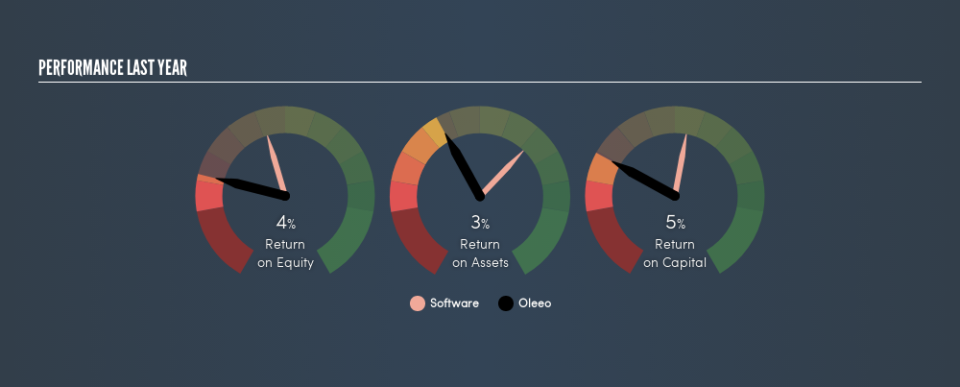How Do Oleeo Plc’s (LON:OLEE) Returns On Capital Compare To Peers?

Today we are going to look at Oleeo Plc (LON:OLEE) to see whether it might be an attractive investment prospect. To be precise, we'll consider its Return On Capital Employed (ROCE), as that will inform our view of the quality of the business.
First up, we'll look at what ROCE is and how we calculate it. Second, we'll look at its ROCE compared to similar companies. And finally, we'll look at how its current liabilities are impacting its ROCE.
Understanding Return On Capital Employed (ROCE)
ROCE is a metric for evaluating how much pre-tax income (in percentage terms) a company earns on the capital invested in its business. In general, businesses with a higher ROCE are usually better quality. Overall, it is a valuable metric that has its flaws. Renowned investment researcher Michael Mauboussin has suggested that a high ROCE can indicate that 'one dollar invested in the company generates value of more than one dollar'.
So, How Do We Calculate ROCE?
The formula for calculating the return on capital employed is:
Return on Capital Employed = Earnings Before Interest and Tax (EBIT) ÷ (Total Assets - Current Liabilities)
Or for Oleeo:
0.047 = UK£473k ÷ (UK£13m - UK£3.0m) (Based on the trailing twelve months to July 2018.)
So, Oleeo has an ROCE of 4.7%.
View our latest analysis for Oleeo
Is Oleeo's ROCE Good?
One way to assess ROCE is to compare similar companies. Using our data, Oleeo's ROCE appears to be significantly below the 11% average in the Software industry. This performance could be negative if sustained, as it suggests the business may underperform its industry. Aside from the industry comparison, Oleeo's ROCE is mediocre in absolute terms, considering the risk of investing in stocks versus the safety of a bank account. Readers may find more attractive investment prospects elsewhere.
Oleeo's current ROCE of 4.7% is lower than 3 years ago, when the company reported a 13% ROCE. So investors might consider if it has had issues recently.
Remember that this metric is backwards looking - it shows what has happened in the past, and does not accurately predict the future. ROCE can be misleading for companies in cyclical industries, with returns looking impressive during the boom times, but very weak during the busts. This is because ROCE only looks at one year, instead of considering returns across a whole cycle. If Oleeo is cyclical, it could make sense to check out this free graph of past earnings, revenue and cash flow.
How Oleeo's Current Liabilities Impact Its ROCE
Current liabilities include invoices, such as supplier payments, short-term debt, or a tax bill, that need to be paid within 12 months. Due to the way ROCE is calculated, a high level of current liabilities makes a company look as though it has less capital employed, and thus can (sometimes unfairly) boost the ROCE. To counter this, investors can check if a company has high current liabilities relative to total assets.
Oleeo has total assets of UK£13m and current liabilities of UK£3.0m. As a result, its current liabilities are equal to approximately 23% of its total assets. This very reasonable level of current liabilities would not boost the ROCE by much.
Our Take On Oleeo's ROCE
That said, Oleeo's ROCE is mediocre, there may be more attractive investments around. You might be able to find a better investment than Oleeo. If you want a selection of possible winners, check out this free list of interesting companies that trade on a P/E below 20 (but have proven they can grow earnings).
I will like Oleeo better if I see some big insider buys. While we wait, check out this free list of growing companies with considerable, recent, insider buying.
We aim to bring you long-term focused research analysis driven by fundamental data. Note that our analysis may not factor in the latest price-sensitive company announcements or qualitative material.
If you spot an error that warrants correction, please contact the editor at editorial-team@simplywallst.com. This article by Simply Wall St is general in nature. It does not constitute a recommendation to buy or sell any stock, and does not take account of your objectives, or your financial situation. Simply Wall St has no position in the stocks mentioned. Thank you for reading.


